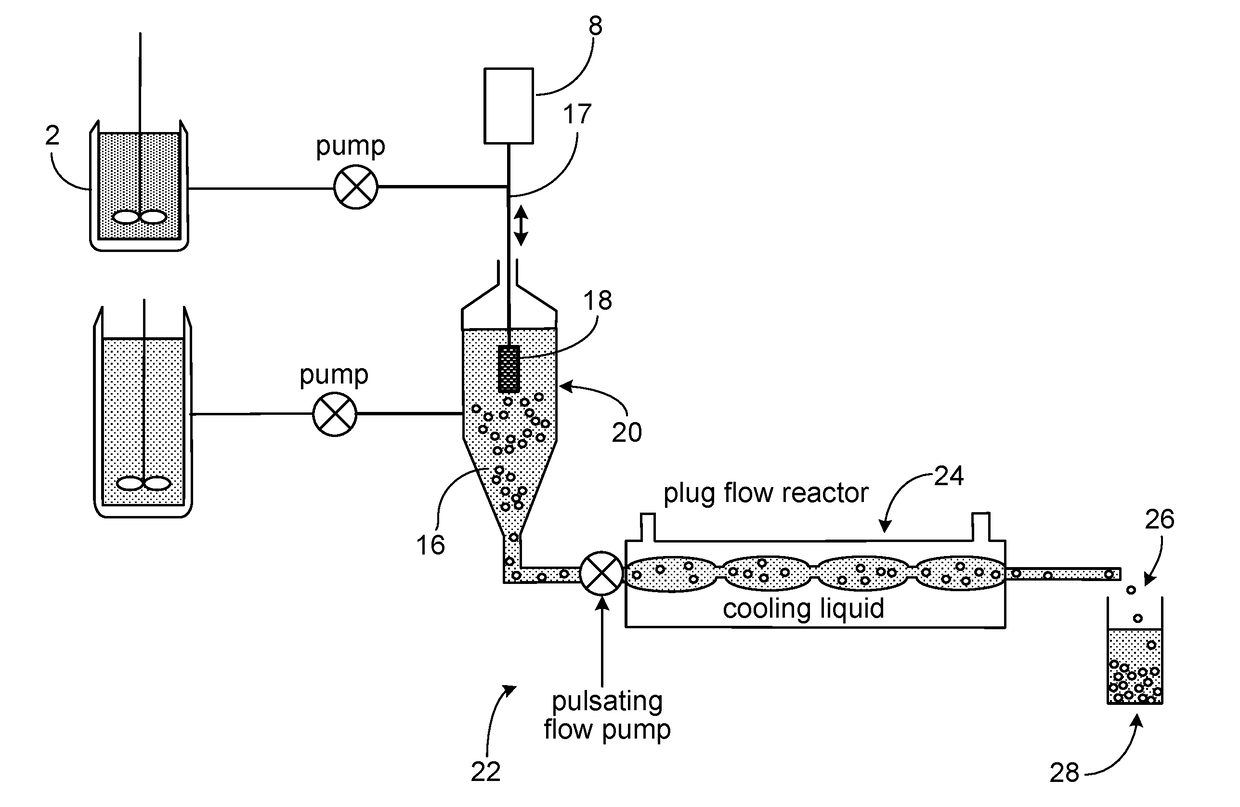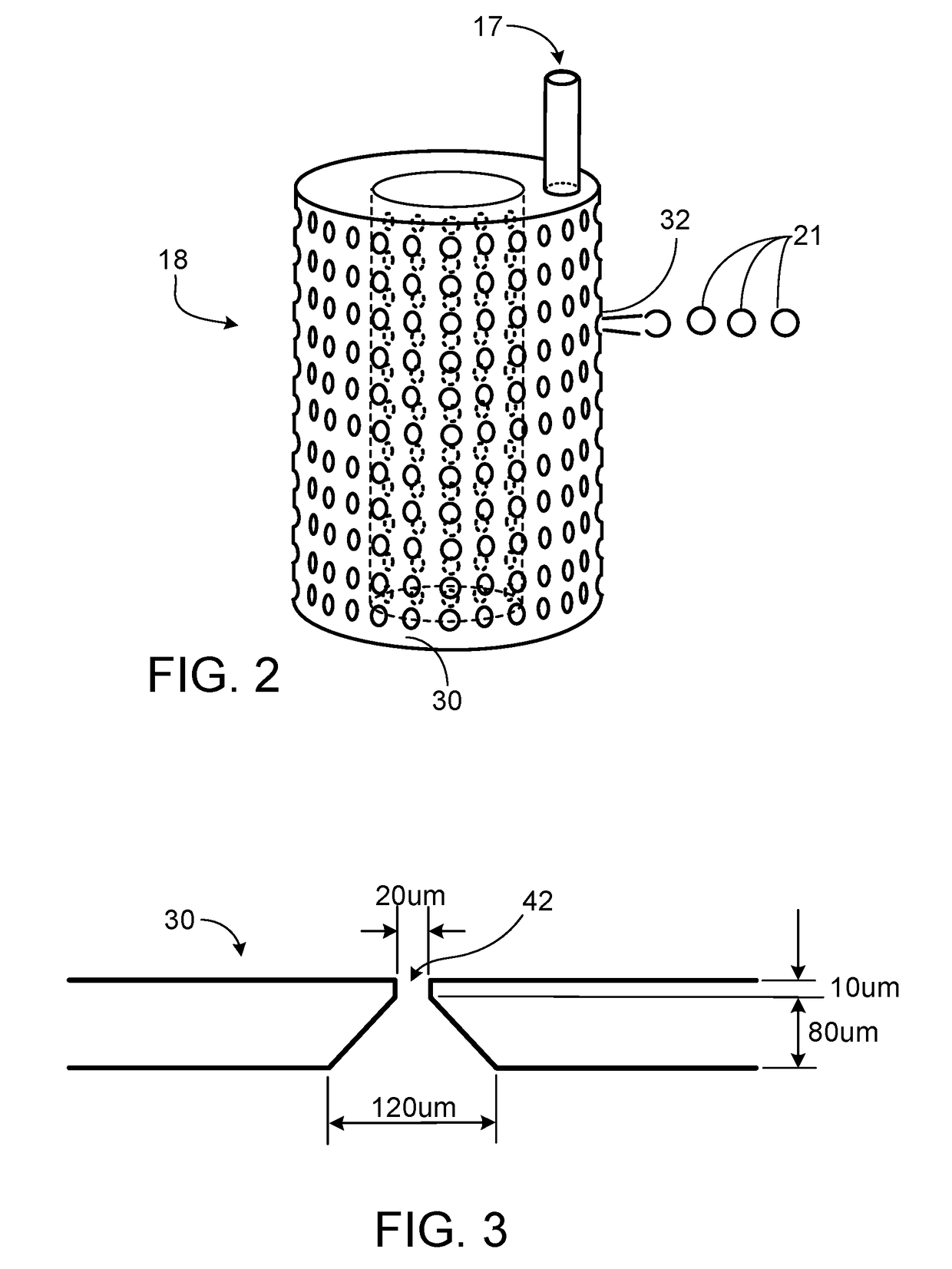Method of producing uniform polymer beads by vibration jetting with superhydrophobic membrane
a superhydrophobic membrane and vibration jetting technology, applied in the direction of vibration granulation, chemical coating, liquid/solution decomposition chemical coating, etc., can solve the problems of large particle size distribution of bead products, low yield of particle size products less than 300 m, and existing jetting methods that suffer from high cost and low output, so as to achieve uniform polymer bead characteristics and long service life.
- Summary
- Abstract
- Description
- Claims
- Application Information
AI Technical Summary
Benefits of technology
Problems solved by technology
Method used
Image
Examples
example 1
[0043]Preparation of a membrane with a superhydrophobic surface. A nickel plate having about 1500 pores per cm2, each pore of 16 μm diameter, formed by electroforming, was fabricated into a double-walled cylindrical can shape (“can”). The can was then cleaned by soaking in 10% sodium hydroxide solution for 30 minutes, followed by a water wash. The can was then soaked in 5% citric acid solution for 30 minutes, followed by a water wash. The cleaned can was then soaked in a phosphorous nickel water solution (nickel 80 g / l (70-90 g / l)
[0044]Phosphorus 25 g / l (20-30 g / l)) at room temperature for 1 minute. The can was transferred to a tank containing PTFE electroless nickel plating solution held at 85° C. and the plating maintained for 10-30 minutes. (from Caswell Europe). The can was then washed with sonication in an ultrasonic water bath, and dried at 160° C. for 2 hours. The can was then washed in a toluene bath 3 times, and then dried at 60° C. for 1 hour. The PFTE-coated can was then ...
example 2
Preparation of Uniform Agarose Beads (82 μm Volume Mean Diameter)
[0045]Agarose beads of uniform particle size were manufactured using the apparatus configuration shown in FIG. 1. An agarose phase (dispersed phase) was prepared at neutral pH containing:
Distilled water1.8kgAgarose84.5g
[0046]The continuous (suspension) phase consists of mineral oil SIPMED 15 with 1.5% SPAN 80 non-ionic surfactant (sorbitan oleate) in it.
[0047]The dispersed monomer phase was prepared in a 3 liter jacketed reactor with paddle overhead stirrer by suspension of agarose in water at room temperature. The temperature was increased to 90° C. and stirred at this temperature for 90 minutes. The temperature was then reduced to 80° C. (which was the injection temperature). The dispersed phase was then fed to the membrane at a flow rate of 16 ml / min.
[0048]The membrane used in this Example was a 4×4 cm (L / d) nickel-based superhydrophobic membrane (pure nickel) containing around 250,000 16 μm conical through holes co...
example 3
Preparation of Uniform Agarose Beads (63 μm Volume Mean Diameter)
[0049]Example 2 was repeated except that the frequency of membrane vibration was 21.5 Hz and amplitude was 3 mm. After separating the agarose beads from oil and washing, the following properties were noted: Volume average particle diameter 63 μm; uniformity coefficient of 1.20; and SPAN=0.32.
PUM
| Property | Measurement | Unit |
|---|---|---|
| volume average particle diameter | aaaaa | aaaaa |
| diameter | aaaaa | aaaaa |
| diameter | aaaaa | aaaaa |
Abstract
Description
Claims
Application Information
 Login to View More
Login to View More - R&D Engineer
- R&D Manager
- IP Professional
- Industry Leading Data Capabilities
- Powerful AI technology
- Patent DNA Extraction
Browse by: Latest US Patents, China's latest patents, Technical Efficacy Thesaurus, Application Domain, Technology Topic, Popular Technical Reports.
© 2024 PatSnap. All rights reserved.Legal|Privacy policy|Modern Slavery Act Transparency Statement|Sitemap|About US| Contact US: help@patsnap.com










